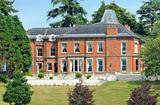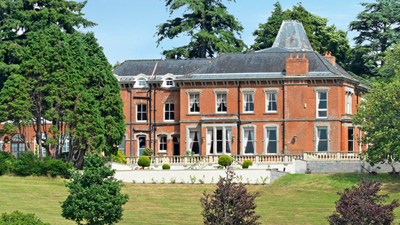Welsh border properties for sale
Now tranquil homes, these properties on the Welsh border have seen plenty of action


Wedged between dramatic Welsh mountains and fertile English river valleys, the border area known as the Welsh Marches is a picturesque landscape of mountains, moorland, farms, wooded valleys, scattered villages and half-timbered buildings, dotted here and there with the romantic remains of long-abandoned medieval castles.
Historically, the Marches (from the Saxon for ‘boundary') were an area of frequent conflict between English rulers and the rebellious Welsh, who didn't take kindly to foreign incursions. In the 8th century, King Offa of Mercia sought to protect his kingdom by building his famous Dyke linking the Severn valley with the North Wales coast. Then, the Normans found an ingenious alternative to direct confrontation with the Welsh, by creating a buffer zone ruled by ‘Marcher' lords who administered their fiefdoms as they wished from fortified castles built at regular intervals along the border.
In later, less turbulent times, the Marches retained their unique Anglo-Welsh character and, by the 18th and 19th centuries, large parts of the region had been absorbed into great estates owned by influential families from both sides of the national divide. All was calm after the First World War, when hundreds of country estates were disposed of by landowning families, including the 1,922-acre Cyfronydd estate near Welshpool, Montgomeryshire (now Powys), ancestral home of the Pryces, a noble Welsh family descended from a medieval king of Powys. When Maj Hamilton Pryce sold Cyfronydd in 1927, the main house, Cyfronydd Hall, had 19 bedrooms and one bathroom. Eleven years later, the estate came back on the market and, this time, the hall was offered with 14 bedrooms, four bathrooms and 44 acres of land, at £7,250. Now, recently restored, Cyfronydd Hall is for sale with 10 bedrooms, 10 bathrooms and 12.7 acres of land, at a guide price of £2.5 million through Savills (01952 239500).

In 1938, the hall was bought by Montgomeryshire County Council and used as a residential girls' school from the 1940s until the 1990s. In 1999, it was acquired in poor condition by its current owners, Jeff and Jean Bowskill, who have spent the intervening years restoring Cyfronydd Hall, its gardens and outbuildings. The process became a voyage of discovery as they removed layer upon layer of partitions, false ceilings, false walls, false floors and 60 years of institutional impedimenta to reveal the original country house beneath.
The present hall was built in about 1865 to replace a traditional, 17th century, black-and-white house destroyed by fire. Pevsner describes the new building as a ‘large square brick house... with vaguely French detail, particularly on the three-storey entrance tower with its chateau roof'-a somewhat lukewarm appraisal of an elegantly symmetrical country house built around an impressive central atrium flooded with light from the glass ceiling overhead. Radiating out from the hall are the main reception rooms-drawing room, dining room, sitting room and library-all of which have large sash windows with spectacular panoramic views over the rolling countryside of the majestic Banwy valley. An intimate study overlooks the rear garden, with its towering beeches, oaks and cedars. The first floor houses the splendid master suite and five further bedrooms, which all have luxurious bathrooms. Four more bedrooms and bathrooms, each with its own quirky, individual character, are located on the floor above.
* Subscribe to Country Life this Christmas and receive a bottle of single malt
Step through an imaginary green baize door and there are the former service quarters, where industrial school kitchens have given way to a modern ‘island' kitchen in Welsh oak, with a breakfast and family area leading to the hall's only 21st-century additions- a large orangery overlooking a raised terrace and those incredible views plus a sumptuous swimming pool and fitness suite wired for soothing sound. Outdoors, the work goes on in the gardens, where the restoration of a one-acre walled garden on the northwest boundary is a project waiting to happen, as Mrs Bowskill completes the conversion of the former outbuildings and coach houses into six stylish guest, staff or holiday cottages.
Exquisite houses, the beauty of Nature, and how to get the most from your life, straight to your inbox.
Also worth mentioning are the hall's wonderfully efficient heating system, its remarkable collection of furniture and artefacts sourced from all round the world-some of which are available for sale separately-and its easy access to the national rail and motorway network, with Welshpool commercial airport only 8 miles away.
From shortly after the Norman Conquest until the early 15th century, the Herefordshire village of Wigmore, eight miles from Leominster, was the seat of the Mortimer family, quintessential Marcher lords who used their influence at Court to gain land and power. Following their eventual fall from grace, their magnificent Wigmore Castle remained a base of major strategic importance during the later medieval and Tudor periods, before being deliberately destroyed during the Civil War to prevent its use as a base by the Royalists.
Today, the principal surviving relic of the Mortimer era in Wigmore is Elizabethan Wigmore Hall, listed Grade II, a two-storey, black-and white, timber-framed house, originally built in about 1480, probably by Edward, Duke of York, who inherited the Mortimers' Wigmore estates following his father's death at the battle of Wakefield during the Wars of the Roses. The house, described by Pevsner as ‘eminently picturesque', stands on the southern edge of the village and has been beautifully modernised and refurbished by its current owners, who bought it some 10 years ago.

Currently for sale through Knight Frank (01432 273087) and Strutt & Parker (01584 873711), at a guide price of £1.35m, Wigmore Hall is an interesting mix of old and new, the north wing having been rebuilt, with the addition of a new kitchen and bedrooms enhanced by shiny new bathrooms. The house, which boasts 5,200sq ft of accommodation-including three reception rooms, a billiard room, a kitchen/breakfast room and four bathrooms-stands in 10 acres of walled garden, parkland and paddocks, with an annexe and extensive outbuildings that include a cottage, offices and stables.
* Beautiful country houses for sale in Wales
* Follow Country Life property on Twitter
Country Life is unlike any other magazine: the only glossy weekly on the newsstand and the only magazine that has been guest-edited by His Majesty The King not once, but twice. It is a celebration of modern rural life and all its diverse joys and pleasures — that was first published in Queen Victoria's Diamond Jubilee year. Our eclectic mixture of witty and informative content — from the most up-to-date property news and commentary and a coveted glimpse inside some of the UK's best houses and gardens, to gardening, the arts and interior design, written by experts in their field — still cannot be found in print or online, anywhere else.

